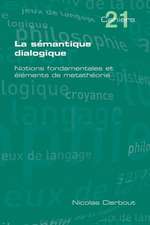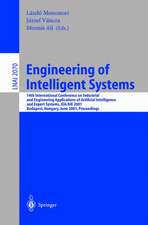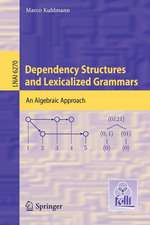Healthcare and Artificial Intelligence
Editat de Bernard Nordlinger, Cédric Villani, Daniela Rusen Limba Engleză Hardback – 18 mar 2020
| Toate formatele și edițiile | Preț | Express |
|---|---|---|
| Paperback (1) | 181.08 lei 3-5 săpt. | |
| Springer International Publishing – 21 aug 2021 | 181.08 lei 3-5 săpt. | |
| Hardback (1) | 216.28 lei 38-44 zile | |
| Springer International Publishing – 18 mar 2020 | 216.28 lei 38-44 zile |
Preț: 216.28 lei
Preț vechi: 270.34 lei
-20% Nou
Puncte Express: 324
Preț estimativ în valută:
41.42€ • 42.68$ • 34.70£
41.42€ • 42.68$ • 34.70£
Carte tipărită la comandă
Livrare economică 20-26 februarie
Preluare comenzi: 021 569.72.76
Specificații
ISBN-13: 9783030321604
ISBN-10: 3030321606
Pagini: 279
Ilustrații: XVIII, 279 p. 48 illus., 26 illus. in color.
Dimensiuni: 155 x 235 x 22 mm
Greutate: 0.74 kg
Ediția:1st ed. 2020
Editura: Springer International Publishing
Colecția Springer
Locul publicării:Cham, Switzerland
ISBN-10: 3030321606
Pagini: 279
Ilustrații: XVIII, 279 p. 48 illus., 26 illus. in color.
Dimensiuni: 155 x 235 x 22 mm
Greutate: 0.74 kg
Ediția:1st ed. 2020
Editura: Springer International Publishing
Colecția Springer
Locul publicării:Cham, Switzerland
Cuprins
Introduction.- Artificial Intelligence and Tomorrow's Health.- Databases.- Matching an Epidemiological Cohort to Medico-Administrative Databases.- Medical and Administrative Data from Health Insurance.- How the SNIIRAM–PMSI Database Enables the Study of Surgical Practices.- Hospital Databases.- The Experience of the Institut Curie.
Notă biografică
Bernard Nordlinger is a Professor of Surgical Oncology—Université de Versailles, APHP, and co-organizer of the IA and Health Working Group of the Académie nationale de Médecine and Académie des sciences.
Cédric Villani is a mathematician, Fields Medal winner, Professor at the Claude Bernard Lyon 1 University, member of the Academy of Sciences, member of French Parliament, and first vice-president of the Office parlementaire d'évaluation des choix scientifiques et technologiques (OPECST).
Daniela Rus is Director of the Computer Science and Artificial Intelligence Laboratory (CSAIL) and Andrew and Erna Viterbi Professor at the Department of Electrical Engineering and Computer Science (EECS), Massachusetts Institute of Technology.
Cédric Villani is a mathematician, Fields Medal winner, Professor at the Claude Bernard Lyon 1 University, member of the Academy of Sciences, member of French Parliament, and first vice-president of the Office parlementaire d'évaluation des choix scientifiques et technologiques (OPECST).
Daniela Rus is Director of the Computer Science and Artificial Intelligence Laboratory (CSAIL) and Andrew and Erna Viterbi Professor at the Department of Electrical Engineering and Computer Science (EECS), Massachusetts Institute of Technology.
Textul de pe ultima copertă
This book provides an overview of the role of AI in medicine and, more generally, of issues at the intersection of mathematics, informatics, and medicine. It is intended for AI experts, offering them a valuable retrospective and a global vision for the future, as well as for non-experts who are curious about this timely and important subject. Its goal is to provide clear, objective, and reasonable information on the issues covered, avoiding any fantasies that the topic “AI” might evoke. In addition, the book seeks to provide a broad kaleidoscopic perspective, rather than deep technical details.
Caracteristici
Presents a vision of the future of medicine enabled by AI Demonstrates the revolution in health care practices now becoming possible thanks to AI Edited by well-known experts including the fields medalist Cedric Villani, who is the current first vice-president of the Scientific Parliamentary Office Explores a number of challenges: technical and technological challenge due to the size of the data involved; ethical and legal challenges like protecting personal data; and challenge of confidence, to convince the actors to overcome their reluctance and share data Includes contributions by leading mathematicians, computer scientists, statisticians, oncologists, surgeons, onco-geneticists, sociologists, hospital administrators, and lawyers to provide the reader with clear, objective, and reasonable information, while avoiding fantasies Highlights various areas of innovation, such as renewing and improving the interpretation of images, modeling tumor growth, predicting response to administered treatments, increasing performance in radiology, pathology and dermatology, taking advantage of genetic data to understand diseases, developing precision medicine, and structuring large databases with vast amounts of data



























